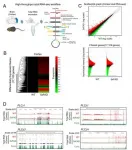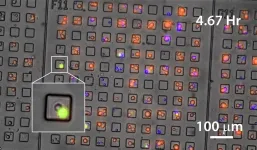When foams collapse (and when they don't)
High-speed video microscopy reveals the complex mechanics of foam collapse
2021-02-27
(Press-News.org) Tokyo, Japan - Researchers from Tokyo Metropolitan University have revealed how liquid foams collapse by observing individual collapse "events" with high-speed video microscopy. They found that cracks in films led to a receding liquid front which sweeps up the original film border, inverts its shape, and releases a droplet which hits and breaks other films. Their observations and physical model provide key insights into how to make foams more or less resistant to collapse.
Understanding how foams collapse is serious business. Whether it's ensuring fire extinguishing foams stay long enough to put out flames, cleaning up toxic foams in seas and rivers, or simply getting the perfect rise on a cake, getting to grips with how foam materials collapse is vital to tailoring their properties, both to keep foams around longer or help them disappear quicker.
That's why a team led by Prof. Rei Kurita of Tokyo Metropolitan University have been carrying out high-speed video microscopy experiments on liquid foams. By generating foams sandwiched between two thin, transparent plates, they have direct access to the whole range of complex phenomena that occur when they begin to collapse. In previous work, they showed that a key way in which foams collapse is via the generation of droplets when individual films rupture. These droplets fly off at high speeds and break other surrounding films, leading to a cascade of breakages that cause the foam to break down. Yet, it was not yet known how exactly the droplets were formed. Importantly, it was not clear when droplets were formed, and when they weren't.
Now, the team has begun to unravel the complex mechanism behind how these droplets are made. When an initial crack forms in a film, the film recedes and leaves a wobbling line of liquid where the original film border was, named as the Released Vertical Plateau Border (RVPB). While it wobbles, there is an accumulation of liquid in the center of the RVPB. When a further crack is created in the remaining film, a receding line of liquid is created which sweeps up the RVPB (see Figure). Interestingly, videos showed that this front has a tendency to invert in shape as it travels. The team found that this is largely due to an inertial effect, as the heavier central part moves less under a constant force. Importantly, it is this inversion that ultimately causes a droplet to be released, initiating a cascade of film breakage events. Their work stands in contrast to previous investigations that looked at standing individual films; the accumulation of liquid in the middle of RVPBs is only possible inside foams, where liquid can be supplied by surrounding films and borders. The physical model they developed to describe the dynamics was shown to give reliable predictions of front velocity and relevant time scales.
Finally, the team replaced lab reagents with a household detergent and repeated the experiment, creating a much more long-lasting foam. When a bubble is burst at the side, they found a similar accumulation of liquid in the center of RVPBs, though significantly less than before. The enhanced elasticity of the film also meant it was extremely unlikely for two cracks to form in the same film; that meant no droplets were formed i.e. no collective bubble collapse: in light of the mechanism found above, this shows conclusively that both less transport within RVPBs and fewer cracks contributed directly to foam stability. Insights like these are vital for guiding the design of new foam materials with enhanced properties; the team hopes that their work may inspire state-of-the-art insulation materials, detergents, food products and cosmetics.
INFORMATION:
This work was supported by a JSPS Research Fellowship for Young Scientists (20J11840), and JSPS KAKENHI Grants-in-Aid for Scientific Research (17H02945, 20H01874, 20K14431).
[Attachments] See images for this press release:

ELSE PRESS RELEASES FROM THIS DATE:
2021-02-27
Korea Brain Research Institute (KBRI, President Suh Pann-ghill) announced that the research team led by Dr. Jae-Yeol Joo discovered new cryptic splice variants and SNVs in PLCg1 gene of AD-specific models for the first time using Splice-AI.
This research outcome was published in PNAS, a world-renowned academic journal.
* (Title) Prediction of Alzheimer's Disease-Specific phospholipase c gamma-1 SNV by Deep Learning-Based Approach for High-Throughput Screening
Alternative splicing variant regulates gene expression and influences diverse phenotypes. Especially, genetic ...
2021-02-26
Marine protected areas (MPAs) around O?ahu do not adequately protect populations of herbivorous reef fishes that eat algae on coral reefs. That is the primary conclusion of a study published in Coral Reefs by researchers from the University of Hawai?i at Mānoa School of Ocean and Earth Science and Technology (SOEST).
There are over 20 species of herbivorous fishes and ten species of herbivorous urchins commonly observed on Hawaiian reefs. These species eat algae that grows on reefs, a process called herbivory, that contributes to the resilience of coral reefs by preventing algae dominance that can lead to overgrowth of corals.
The team of researchers found that of the four marine protected areas around O?ahu they assessed in the study, ...
2021-02-26
The ability to read is foundational to education, but prolonged school closures and distance learning due to the pandemic have imposed unique challenges on the teaching of many fundamental skills. When in-person classes resume, many students will likely need a period of catch-up learning, especially those who lag behind in basic reading skills.
New research published in the journal Psychological Science shows that people who were taught to read by receiving explicit instructions on the relationship between sounds and spelling experienced a dramatic improvement compared to learners who discovered this relationship naturally through the reading process. These results contribute to an ongoing debate about how best to teach children to ...
2021-02-26
New research from Baylor College of Medicine scientists shows that a combination of deep brain stimulation (DBS) and exercise has potential benefits for treating ataxia, a rare genetic neurodegenerative disease characterized by progressive irreversible problems with movement.
Working with a mouse model of the human condition, researchers at Baylor and the Jan and Dan Duncan Neurological Research Institute at Texas Children's Hospital discovered that combining DBS targeted to the cerebellum, a major motor center in the brain, and exercise rescued limb coordination and stepping and that the benefits persisted without further stimulation. In addition, the study reports that stimulating mice with early-stage ataxia showed the most dramatic improvements. These and other ...
2021-02-26
BOSTON -- Billions of peripheral white blood cells are produced every day by the regular divisions of hematopoietic stem cells and their descendants in the bone marrow. Under normal circumstances, thousands of stem cells contribute progeny to the blood at any given time, making white blood cells a group with diverse ancestry.
Clonal hematopoiesis is a common age-related condition in which the descendants of one of these hematopoietic stem cells begin to dominate substantial portions of the blood. Genome-wide analyses have determined that clonal ...
2021-02-26
COLUMBIA, Mo. - While physical activity is important for everyone, research has shown people with developmental disabilities do not exercise as often as their typically developed peers. In an effort to close this disparity, a researcher at the University of Missouri recently created fitness picture books that help youth with autism exercise more frequently while offering low-income families a simple resource for workout motivation when outdoor fitness equipment might not be accessible.
"There is so much research geared toward helping individuals with autism improve their academic ...
2021-02-26
Treatments for beating tumours are mainly based on CD8 T lymphocytes, which specialise in detecting and eliminating intracellular infections and in killing cancer cells. A large proportion of patients, however, do not respond to these treatments. This prompted a research team from the Swiss Cancer Centre Léman (SCCL, Switzerland) to bring together the universities of Geneva (UNIGE) and Lausanne (UNIL), the Ludwig Institute for Cancer Research (LICR), EPFL and CHUV to investigate CD4 T lymphocytes. While these play a supporting role with CD8 T cells, their ability to eliminate tumour cells directly has been a matter of controversy. Using innovative nanoimaging technologies designed at the EPFL laboratory, the scientists found that when the CD4 T lymphocytes ...
2021-02-26
The ocean floor is vast and varied, making up more than 70% of the Earth's surface. Scientists have long used information from sediments at the bottom of the ocean -- layers of rock and microbial muck -- to reconstruct the conditions in oceans of the past.
These reconstructions are important for understanding how and when oxygen became available in Earth's atmosphere and ultimately increased to the levels that support life as we know it today.
Yet reconstructions that rely on signals from sedimentary rocks but ignore the impact of local sedimentary processes do so at their own peril, according to geoscientists including David Fike in Arts & Sciences at Washington University in St. Louis.
Their new study published Feb. ...
2021-02-26
Cells rely on membranes to protect themselves from the outside world. But these membranes can't be fully closed because nutrients and other molecules have to be able to pass through. To achieve this, cell membranes have many types of channels and pores. Also, there are receptors, antennas if you like, imbedded in the membrane that continuously monitor the outside world and signal to the cell interior. Extensive collaboration between five VIB groups resulted in a better understanding of the machinery that plants use to regulate the protein composition of their outer membrane. This discovery, published in Science Advances, enhances our basic knowledge of how the plasma membrane composition can be adapted based on external stimuli, an essential ...
2021-02-26
A team of international researchers went back to the formation of the solar system 4.6 billion years ago to gain new insights into the cosmic origin of the heaviest elements on the period-ic table.
Led by scientists who collaborate as part of the International Research Network for Nuclear Astrophysics (IReNA) (irenaweb.org) and the Joint Institute for Nuclear Astrophysics - Center for the Evolution of the Elements (JINA-CEE) (jinaweb.org), the study is published in the lat-est issue of the journal Science (science.sciencemag.org/content/371/6532/945).
Heavy elements we encounter in our everyday life, ...
LAST 30 PRESS RELEASES:
[Press-News.org] When foams collapse (and when they don't)
High-speed video microscopy reveals the complex mechanics of foam collapse





